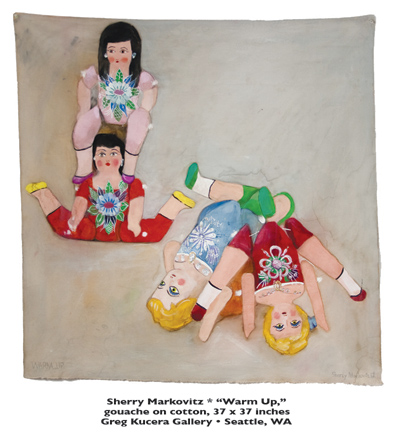
In tandem with Seattle Art Museum's "Elles: Women Artists from the Centre Pompidou" exhibit, Greg Kucera Gallery is featuring "Ladies' Choice," a show wherein every female gallery artist has chosen a female artist from outside the gallery to exhibit alongside them.
Ross Palmer Beecher chose Marita Dingus, Loretta Bennett chose Qunnie Peltway, Claudia Fitch chose Sheila Klein, Victoria Haven chose Dawn Cerny, Susan Skilling chose Claire Cowie, Katy Stone chose Leona Christie while Lynne Woods Turner chose work by Leonie Guyer, Deborah Butterfield chose Mary Ann Kelly.
There seems to be a spirit of patronage and admiration between women artists that didn't exist even a few decades ago when there were still such few slots for females in the art world.
"I remember not even that long ago," says photographer Alice Wheeler who is represented by Kucera, "Guerrilla Girls came to Seattle and there were less than 10% women artists being represented by major art galleries. Greg Kucera has always been very forward, he has almost always had like about a fifty-fifty ratio between men and women artists in his galley. When I first started hanging art almost all of the people I showed with were guys. Previous to Greg Kucera people often said that they were including me because they needed a woman in their show. So at least now I’m known for my work instead of my gender."
Wheeler, recognized for her images of what she calls "street stuff," is submitting a large photograph of an all-pink woman she saw and shot in Pioneer Square named Princess Bubble Gum. Her artist of choice is photographer Kelly O., who The Stranger newspaper describes as their "staff photographer, music writer, Drunk of the Week columnist, and more!"
Kucera artist Deborah Butterfield enth

used about her choice of Montana artist Mary Ann Kelly via telephone after driving 10 hours from Bozeman, Montana to the Walla Walla Foundry where she is preparing for a show at LA Louver Gallery.
"We've known Mary Ann for 37 years and have been together through lives and deaths and births and forest fires," says Butterfield; "I think what draws me to her work. . . you know, we live in Montana in the mountains and so for us nature really is what we deal with every day. . .things like shoveling snow and dealing with large predators. . .we really do address that every day and I think the gestural quality in both of our works kind of addresses the human scale within that huge context. The gesture for me is what I can pick up and stuff into a horse (laughs) and the gesture for Mary Ann is really more within her arms reach. I feel that we're struggling, excited, and responsive to both the structure of nature and then the gesture within that structure. I think her use of color is so strong; the works are lyrical and they’re sensual. She hasn’t had much exposure out of Montana."
Gallery artist Sherry Markovitz chose one of Allison Manch's embroidered works on cloth.

"I like Allison's attitude and use of materials," writes Markovitz; "I like her choice of subject matter and how she weaves her history into her work. . .her imagery has evolved. She has been embroidering images of the Southwest and text from songs."
Markovitz is represented by "Warm Up," a large gouache on cotton. She uses images of both traditional western dolls, dolls that represent folk traditions, and dolls with profound expressions which she animates. Her most recent paintings are of traditional Mexican paper mache dolls in various acrobatic postures.
"I feel," writes Markovitz, "that as long as women are oppressed in some way around the world there is a need to highlight women's work. It can only be empowering."
Kucera Gallery artist Margie Livingston chose work by Seattle's witty Debra Baxter.
"Debra's work hits me with a sense of longing that feels fresh," says Livingston; "I also like the way she works with an extensive range of materials without feeling gimmicky. From paint to powder puffs and everything in between including quartz, alabaster, words, video, mirrors, and cypress knees."
Debra has described her use of crystals as "a way to transform vulnerability into power and also to embrace vulnerability as a type of power."
When did Livingston first see Baxter’s work?

"In 2003, Debra was sewing powder puffs together to make clouds. I don't remember where it was, but at over three feet long they were stunning, memorable, funny, sad, and feminine," says Livingston.
Currently, Livingston is "finishing up several objects made out of paint that blur the line between painting and sculpture. These include a block of paint that weighs over 50 pounds, a grid of 90 color tests, a log of paint that was cut into an 8-foot post, and a folded painting. You’ll be able to see some of them at Greg Kucera in October, in the Bellevue Arts Museum Biennial, and in Miami Beach for the December art fairs."
Deborah Butterfield sums up the sentimentof the show: "There's strength, you know, in being female. I mean, having babies and stuff - it's scary. It's life and death and I think that comes through in our work."
Saylor Jones
Saylor Jones is a Seattle writer and illustrator. Her floral watercolors are exhibited at Mioposto Restaurant from October 3 to December 3. To view her work, visit www.saylorjones.com.
"Ladies' Choice" is on view November 15 through December 29 at the Greg Kucera Gallery, located at 212 Third Avenue South in Seattle, Washington. The opening reception is on November 15, from 6 to 8 P.M. and the First Thursday reception is on December 6, from 6 to 8 P.M. For more information visit www.gregkucera.com.
"Ladies' Choice," is shown in conjunction with "Elles: SAM" exhibit at Seattle Art Museum. Visit Seattle Art Museum's website for list of all the exhibits and events.